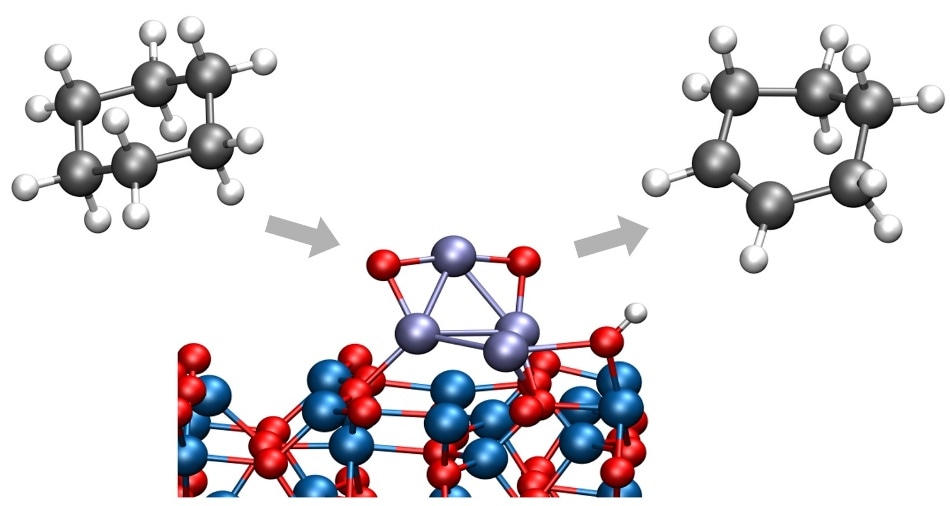Apr 4 2019
It is a fact that chemists devote a considerable amount of their energy and time in an effort to initiate or accelerate chemical reactions—but at times it would be better to halt these reactions before they go extremely far.
 Argonne chemists have identified a way to convert cyclohexane to cyclohexene or cyclohexadiene, both important chemicals in a wide range of industrial processes. The new process takes place at low temperatures, eliminating the creation of unwanted byproducts. (Image credit: Argonne National Laboratory.)
Argonne chemists have identified a way to convert cyclohexane to cyclohexene or cyclohexadiene, both important chemicals in a wide range of industrial processes. The new process takes place at low temperatures, eliminating the creation of unwanted byproducts. (Image credit: Argonne National Laboratory.)
Now, chemists from the U.S. Department of Energy’s (DOE) Argonne National Laboratory have discovered a new method to change cyclohexane into important chemicals—that is cyclohexadiene or cyclohexene—in a recently conducted study. Many industrial processes are known to use these vital chemicals. Most significantly, this process occurs at low temperatures, which means there is no need to create carbon dioxide gas that would have occurred from an undesirable breaking of carbon-carbon bonds.
According to Argonne chemist Stefan Vajda, who is currently at the J. Heyrovský Institute of Physical Chemistry in Prague, cyclohexane happens to be a crucial starting molecule in many different chemical reactions. However, in the absence of an appropriate catalyst to start the reaction, changing cyclohexane into valuable products will generally need very high temperatures produced at the cost of a considerable amount of energy, and added to this, the process may also suffer from poor selectivity
In the latest analysis, Argonne chemist Larry Curtiss, Vajda, and their international group of collaborators analyzed a type of reaction known as oxidative dehydrogenation, wherein a larger molecule is removed from hydrogen molecules. By reducing a restricted number of carbon-hydrogen bonds, the reaction can create cyclohexadiene and cyclohexene before combustion to carbon dioxide occurs.
The new study improved on earlier researches performed by Argonne scientists on the dehydrogenation of cyclohexene and cyclohexane by introducing two major components— a controlled oxygen environment and a cobalt oxide catalyst of sub-nanometer size on an aluminum oxide support.
Then, at Argonne’s Advanced Photon Source (APS), a DOE Office of Science User Facility, the investigators utilized X-ray scattering methods to track the stability and nature of the catalysts during real-time catalytic testing of the clusters. They eventually found that partial dehydrogenation of the cyclohexane was carried out by these clusters at temperatures of approximately 100 °C—much lower than had been previously seen for a reaction like this. At reaction temperatures around 300 °C, the clusters retained their stability and oxidized nature.
The fact that we can make this conversion happen at lower temperatures protects the intermediate dehydrogenation products cyclohexene and cyclohexadiene from being further converted to unwanted products.
Stefan Vajda, Chemist, J. Heyrovský Institute of Physical Chemistry
Both Curtiss and Vajda observed that the highly selective catalyst lasts for a long time and does not get degraded or poisoned by the reaction. In experimental and theoretical analyses of the catalyst size, the team discovered that clusters of size 4 and 27 atoms were more or less equally efficient in performing the reaction.
It seems as though as long as the catalyst is below roughly one nanometer in size, this composition works well—an important factor for the potential scaleup of this class of catalysts by more traditional, though less size-selective, synthesis routes.
Stefan Vajda, Chemist, J. Heyrovský Institute of Physical Chemistry
In order to gain a deeper insight into the rudimentary mechanisms behind the selectivity and activity of the cobalt catalysts, the investigator employed density functional theory calculations to perfect the reaction pathways.
The excellent performance of the cobalt clusters can be explained by theoretical calculations, which reveal highly active cobalt atoms in the clusters and show that the oxidized nature of the clusters causes the low-temperature formation of the product.
Larry Curtiss, Chemist, Argonne National Laboratory
A paper based on the study titled, “Subnanometer cobalt oxide clusters as selective low temperature oxidative dehydrogenation catalysts,” was published in the February 27th online issue of Nature Communications.
Argonne scientists Sungsik Lee, Avik Halder, Sönke Seifert, Glen Ferguson, and Randall Winans are other authors of the paper, while other contributors included Detre Teschner and Robert Schlögl from the Fritz-Haber-Institut and the Max-Planck-Institute for Chemical Energy Conversion in Germany, Jeffrey Greeley from Purdue University, and Vasiliki Papaefthimiou from the University of Strasbourg in France.
The DOE’s Office of Science and the Air Force Office of Scientific Research funded the study.